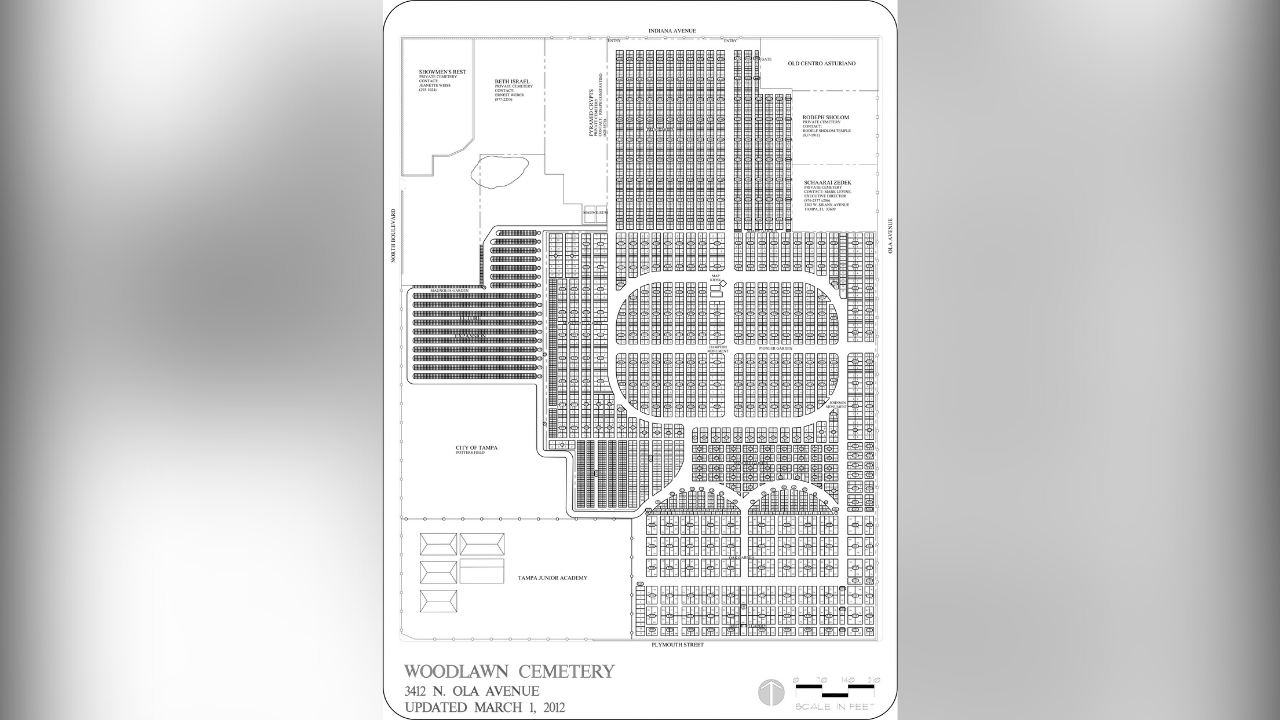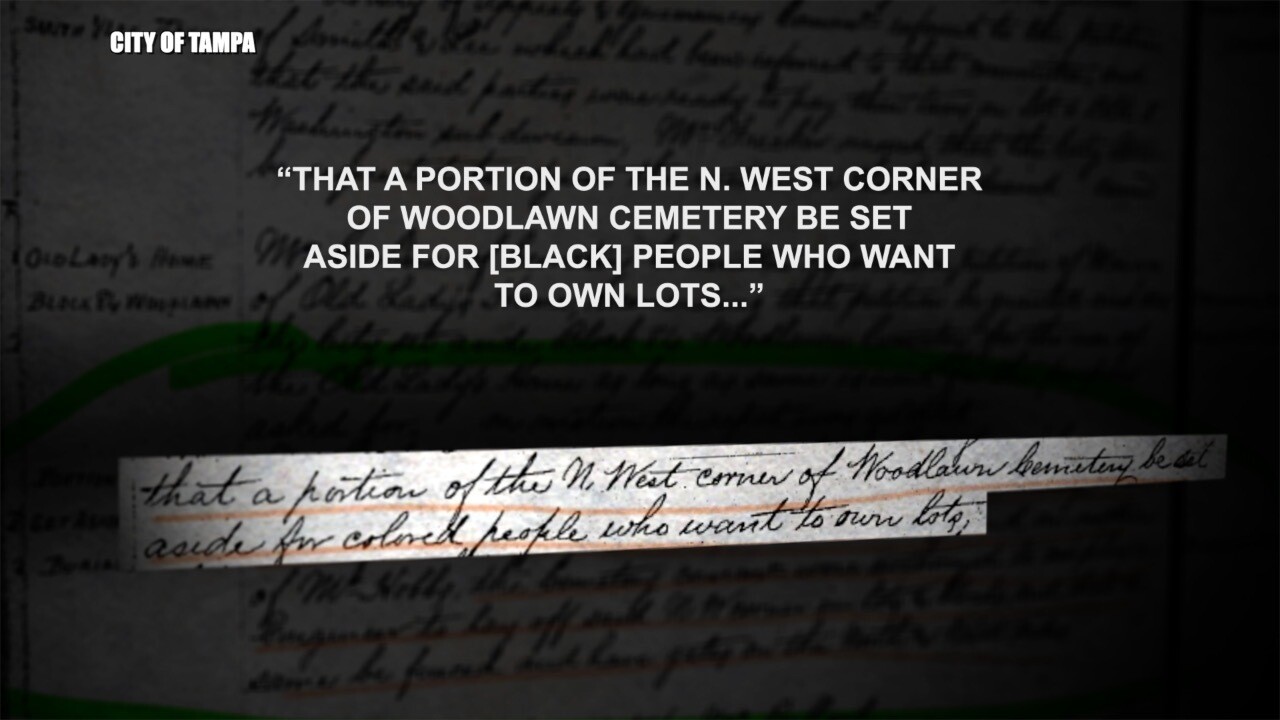TAMPA HEIGHTS, Fla — History is prevalent in Woodlawn Cemetery. Thousands are buried there. Clara Frye, a nurse from Alabama who came down to Tampa in 1901 and built the city’s first Black hospital is buried there too.
It’s quiet and peaceful yet, there’s tension and anticipation among neighbors.
“Tampa has a history of building on top of graves, specifically Black graves, and shame on us,” said Aileen Henderson, a neighbor who is concerned about potential development on private property near Woodlawn. “We are going to repeat history, and we need it to stop.”
“What do we keep covering up? What do we keep hiding?” asked Yvette Lewis, the Hillsborough County Branch President of the NAACP. “Something needs to be done.”
Henderson is behind signs that can be seen staked into front lawns around Tampa Heights.
“The signs that you’re seeing say stop the build, save Woodlawn Cemetery,” she said.

She’s referring to a plot of land adjacent to Woodlawn Cemetery that was sold to private owners in the 1970s. Those owners also own the property to the north called Showmen’s Rest, a cemetery for circus performers.
The owners are ready to part ways with the land. Skyline 41, a past interested buyer, wanted to build townhomes there. According to the Property Appraiser website, the land is situated northwest of Woodlawn along North Boulevard. The property type is listed as cemetery right now, but the owners want to change that.
“It’s cemetery property. It’s sacred land. You don’t build on sacred land,” said Henderson.

She fears there could be bodies buried there and she believes they’re African-Americans based on research she and her team have done over the past few months. She said old city meeting minutes from 1900 show a portion of the northwest corner of Woodlawn Cemetery was to be set aside for Black burials.
"And then we have in 1903, the Odd Fellows Club, where a gentleman, a Black gentleman asked to buy a burial plot in the Black section,” she said.

Henderson can’t quite pinpoint where that exact area would be now because the cemetery has expanded since then. Neither can the city.
“I’ve got maps showing Potters field in 1895 in one location and today’s map showing it in a different location. So, how can we possibly be sure that there are not bodies buried there?” she asked.
Potters field, nationwide, is a common name for a section of indigent or unknown graves. In maps provided by the city, you can see a side-by-side comparison from 1895 and the latest map from 2012 that show Potters field was moved to the west. But, what concerns Henderson, even more, is the presence of three Potters field signs that physically line the entire west side of Woodlawn Cemetery and touch the fence of the private property owned by the Greater Tampa Showmen’s Association.

“Why are we putting up signs indicating that it is Potters field?” Henderson asked. “I would have to guess, it’s pure speculation, that it could quite possibly be because we don’t know for sure.”
The city of Tampa told ABC Action News two of the signs were misplaced.
In 2005, the city conducted a ground-penetrating radar study on the grassy field marked with Potters field signs. It revealed 596 possible grave locations.
In 2019, the northern half of that area was once again surveyed with GPR by anthropologists at USF. They said while there wasn't an overall pattern of grave shafts and rows; anthropologists should be present and care should be taken if they planned to excavate because burials in Potters field are typically expedited and done with cheaper materials that could cause anomalies.
The city also said at one point, the County was burying people in Woodlawn cemetery in Potters field.
The 2019 study references what Henderson found — the city’s decision to set aside a portion of the Northwest corner of Woodlawn for Black burials.
“It is unclear what the exact boundaries of the African-American portion of Woodlawn Cemetery mentioned in the articles above were, or how many people were buried in the area at that time," Henderson said. "But today, the northwest corner of Woodlawn Cemetery is the location of the more recent Showmen’s Rest and Beth Israel Cemeteries. More research should be done to look at the original plat of Woodlawn Cemetery and determine the potential boundaries for this earlier cemetery section, along with the names of any people buried there.”

Lewis said the information Henderson and her team found casts enough doubt in her mind.
“If you don’t understand your history, your history has a tendency of repeating itself,“ she said. “Is this land that important that you would disrupt the people that you would build on something that has such a huge question mark over?”
While Skyline told ABC Action News it removed itself as an agent/applicant for the change in land use, it sent over the results of two geophysical investigations that were done at the one-acre site in 2019 and 2021. Both found several dozen suspected objects one to two feet in diameter buried at a depth of five to eight feet.
While the company behind the studies notes it didn’t find, “buried graves that would be associated with casket burials,” it’s not possible without hand digging and physical confirmation that these objects are man introduced, or naturally occurring like tree stumps, rocks, or balls of clay.
But it did say the small and large objects found weren't associated with the length and width of typical graves.
Jeff Moates, a USF-based archaeologist that’s helped uncover lost or built-over African-American cemeteries across the Tama Bay area sent his thoughts on the studies through e-mail:
“These were conducted by geo-technicians, not archaeologists. Their methods of study are not consistent with identifying human burials. It is entirely possible that graves exist in this area."
But, he said there's no proof these potential graves are Black burials.
ABC Action News spoke to Teresa Caddick, the President for Showmen’s Rest and she sent a statement that read:
“My opinion is we’ve done our due diligence, it’s private property, it’s not part of Woodlawn Cemetery. We’ve done two tests both of which showed no burials and what we’re asking for is a land use change, the same rights that any private property owner has out there in that area.”
The discovery of Black burials underneath the Robles Park housing development in 2019, also known as the forgotten Zion Cemetery, has been the catalyst to change in the Florida state legislature.
State Representative Fentrice Driskell created an Abandoned African-American Cemeteries Taskforce that would recommend how the state moves forward in recording, studying, and remembering forgotten Black cemeteries.
“In Florida, we are very strong on property rights and we want to make sure we aren’t doing anything to weaken that,” she said. “But, at the same time, we can acknowledge there may be a compelling public policy interest or community interest in investigating whether there is a cemetery on a private property.”
Lewis, who is a member of the task force, understands private owners have rights but she thinks more can be done at this site to be absolutely sure.
“I’m just asking the city of Tampa, let’s figure this out together,” she said. “Let’s work together, let’s right this wrong part of history.”
The land-use change is going before the Tampa City Council on February 24, 2022. ABC Action News will follow this topic and let you know what's decided.





